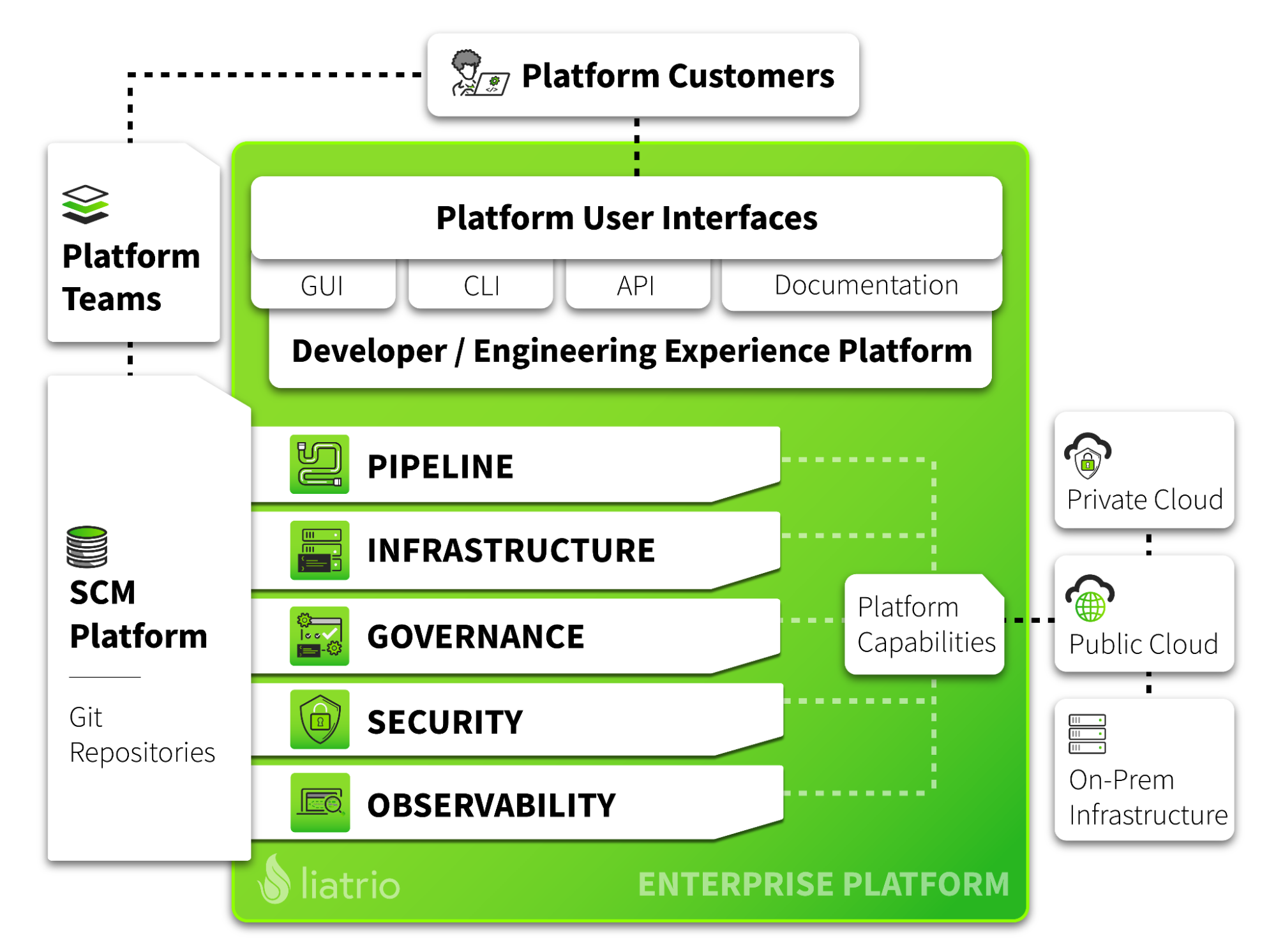Delivery Platform
What is a Delivery Platform?¶
A delivery platform is a comprehensive system designed to simplify and accelerate digital product development, deployment, and management. It is a crucial toolset for developers, enhancing their ability to turn ideas into customer-ready solutions efficiently. The platform stands out by prioritizing the developer experience, making it user-friendly and collaborative, and fostering innovation and productivity.
It addresses the challenges organizations face in adapting to rapid technological changes, enabling even non-tech-focused companies to embrace DevOps practices. Essentially, it acts as a bridge, offering scalable and secure infrastructure along with a comprehensive suite of services that expertly guide developers on the best path to success.
Organizations can create a dynamic and engaging environment by viewing the delivery platform as a product. This speeds up the delivery process and ensures products meet high standards of quality and security. At its core, the platform empowers developers with the right tools and support, making it easier for them to deliver exceptional value to the organization and its customers.
What does a Platform look like?¶
Platforms need to make things easy and enjoyable for developers to truly stand out. It doesn't matter if they have a flashy look; what's important is that they come with clear instructions that make it straightforward to use the services and tools they offer. Instead of telling developers exactly what to do, the best platforms offer helpful tips and shortcuts, known as the "golden path." This isn't about restricting creativity but providing a map to success that teams can follow, blending guidance with the freedom to explore and innovate.

Platform as a Product¶
Successful platforms rely on a set of common features and principles regardless of their industry. Key concepts like flexibility in code structure and team operation are crucial. Everyone involved, from creators to managers to users, needs to share a unified goal and commit to these core principles.
Small, empowered teams with access to self-service tools are the driving force behind effective platforms. Whether focusing on direct customer value or developing internal tools and libraries, the ability to minimize overlapping duties empowers these teams to deliver streamlined, independent value.
When designing tools for internal use, treat them as if they're for external clients. Incorporate easy-to-understand guidance and feedback mechanisms, ensuring minimal learning curves and fostering open communication between users and developers. By developing reusable solutions that align with best practices, you establish a straightforward, adaptable development pathway, encouraging innovation and collaborative refinement at every step.
Thinnest Viable Platform (TVP)¶
The TVP is crucial in enabling stream-aligned teams to deliver value efficiently. The TVP is a minimal set of platform capabilities and services that support the rapid and reliable delivery of software without overwhelming the teams with complexity or unnecessary features. This approach focuses on providing just enough platform functionality to meet current needs while maintaining the flexibility to evolve as requirements change.
Core Principles¶
- Simplicity and Usability: The TVP should be straightforward to use, focusing on reducing cognitive load for your stream-aligned teams. This enables teams to concentrate on delivering business value rather than wrestling with platform complexities.
- Minimum Viable Product (MVP) Approach: Similar to building a product, the platform starts with the most basic features that fulfill user needs. This iterative approach allows for continuous feedback and improvements, ensuring the platform evolves in alignment with the requirements of its users.
- Enablement over Enforcement: The platform should empower your teams by providing tools and services that are easy to adopt rather than imposing strict constraints or mandatory processes.
Designing a TVP¶
- Identify Core Services: Determine the essential services that provide the most value to your teams. Common examples include container orchestration, continuous integration/continuous deployment (CI/CD) pipelines, logging, monitoring, and security services.
- Focus on Developer Experience: Ensure the platform enhances productivity and is developer-friendly. This includes having clear and concise documentation, straightforward setup procedures, and robust support mechanisms.
- Implement Feedback Loops: Regularly collect feedback from the users of the platform (the developers) to understand their needs, pain points, and suggestions for improvement. Use this feedback to prioritize enhancements and new features.
- Emphasize Reliability and Scalability: Even at its thinnest, the platform must be reliable and scalable. It should support the operational needs of the software being developed, with the ability to grow as demand increases.
Benefits of a TVP¶
- Increased Efficiency and Productivity: A TVP reduces the time and effort required to develop, test, and deploy software by providing a streamlined set of tools and services.
- Improved Focus: Teams can concentrate on delivering business value and innovation rather than building and maintaining essential infrastructure and tooling.
- Faster Time to Market: The TVP's simplified processes and automation capabilities enable quicker iterations and deployments, reducing the overall time to market for new features and products.
- Flexibility and Adaptability: A lean platform approach allows for easier adjustments and updates, making the platform more responsive to the changing needs of the business and technology landscape.